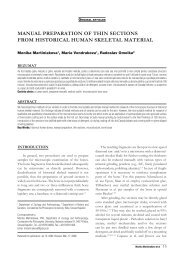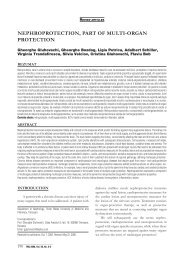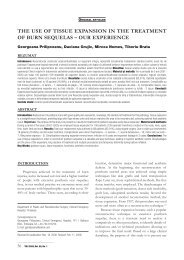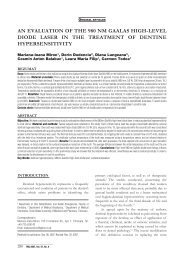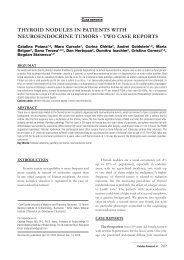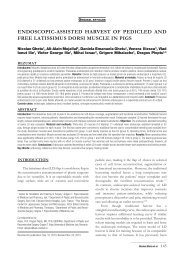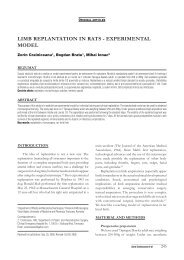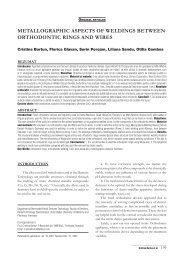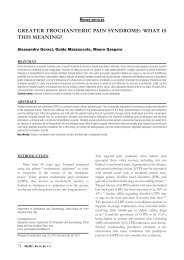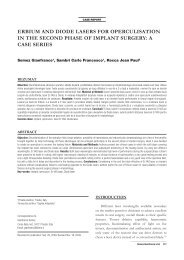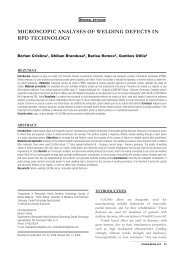FocUsEd assEssMEnt sonography For traUMa In "casa aUstrIa ...
FocUsEd assEssMEnt sonography For traUMa In "casa aUstrIa ...
FocUsEd assEssMEnt sonography For traUMa In "casa aUstrIa ...
You also want an ePaper? Increase the reach of your titles
YUMPU automatically turns print PDFs into web optimized ePapers that Google loves.
Original articleS<br />
<strong>FocUsEd</strong> <strong>assEssMEnt</strong> <strong>sonography</strong> <strong>For</strong> <strong>traUMa</strong><br />
<strong>In</strong> "<strong>casa</strong> <strong>aUstrIa</strong>" poLy<strong>traUMa</strong> cEntEr<br />
- onE yEar FroM thE opEn<strong>In</strong>g<br />
Sorin chiriac 1 , Mirela Danila 2 , cristian nica 3 , claudiu andrei 1 , Dorin claici 4 ,<br />
Mircea Popescu 1<br />
rEZUMat<br />
<strong>In</strong>troducere: Ultrasonografia (US) este recunoscut\ ca metod\ de screening �n serviciile de urgen]\. Astfel, �n traumatologie, "Focused Assessment<br />
Sonography for Trauma" (FAST) asigur\ �n principal o identificare rapid\ a colec]iilor lichidiene intraperitoneale, retroperitoneale, pleurale, pericardice, parietale,<br />
etc. Material [i metod\: Studiul s-a efectuat la Compartimentul de Politraumatologie "Casa Austria" din cadrul Spitalului Clinic de Urgen]\ Jude]ean<br />
Timi[oara, pe o perioad\ de un an (august 2003 - august 2004), pe un num\r de 130 pacien]i cu politraumatisme sub 24 ore. S-au �nregistrat 94 b\rba]i (72%),<br />
36 femei (28%), cu v�rste �ntre 15 [i 79 ani (media 41 ani), prin accidente rutiere - 75 de cazuri (57,7%), prin c\dere de la �n\l]ime - 31 de cazuri (23,8%), prin<br />
heteroagresiune - 16 cazuri (12,4%), prin strivire - 3 cazuri (2,3%), alte cauze - 5 cazuri (3,8%). S-au examinat: cavitatea peritoneal\, toracele (spa]iul pleural [i<br />
pericardic) [i parietal la nivelul coapsei [i abdomenului. Rezultate: Rezultate pozitive s-au �nregistrat la 21 cazuri (16,15%) [i rezultate negative la 109 cazuri<br />
(83,85%). Rezultate fals pozitive nu am �nregistrat, fals negative - un caz. Concluzii: Specificitatea a fost 100%, sensibilitatea 95,23% [i acurate]ea 99,23%.<br />
Aceste rezultate, al\turi de durata scurt\ de examinare (2 min.), caracterul non-invaziv, repetitiv [i mobilitatea examin\rii au corespuns datelor din literatura de<br />
specialitate.<br />
Cuvinte cheie: ultrasonografie (US), traumatologie, FAST<br />
abstract<br />
<strong>In</strong>troduction: Ultrasound exploration (US) is a recognized screening method in the Emergency Room (ER). Focused Assessment Sonography for Trauma<br />
(FAST) can be used to rapidly identify liquid collections in peritoneum, retroperitoneum, pleura and pericardium as well as intraparietal collections. Material<br />
and method: The present study was performed in the "Casa Austria" Polytrauma Center of the Clinical Emergency County Hospital, Timisoara, over a one<br />
year period (August 2003 - August 2004). During that period a number of 130 patients with acute (less than 24 hours) polytrauma were admitted. 94 of them<br />
(72%) were males and 36 (28%) were females, with ages ranging from 15 to 79 years (median 41 years). 75 (57.7%) of cases were car accidents, 31 cases<br />
(23.8%) falling from altitude, 16 (12.4%) cases of heteroagression, 3 (2.3%) cases resulting from crushes and 5 (3.8%) of other etiology. We have explored<br />
the abdomen, thorax and the parietal aspects of the thigh and abdominal wall. Results: We have recorded a number of 21 (16.15%) positive cases and 109<br />
(83.85%) negative cases. We have not recorded any false positive cases, and only a false negative one. Conclusions: The specificity was 100%, the sensibility<br />
92.5%, and the accuracy 99.23%. These results, corroborated with the short time needed for the exploration (2 minutes), its multi-repetitive and non-invasive<br />
aspects, correspond to the data found in the specialty literature.<br />
Key Words: ultra<strong>sonography</strong> (US), trauma, FAST<br />
<strong>In</strong>trodUctIon<br />
Ultra<strong>sonography</strong> (US) imposed itself as a screening<br />
method in emergency rooms (ER) everywhere.<br />
The term of “paraclinic exam” is thought to be less<br />
appropriate, the US being considered “the stethoscope<br />
of the 3 rd millennium”. 1<br />
1 "Casa Austria"Polytrauma Center, 2 Clinic of Gastroenetrology, 3 3 rd Clinic of<br />
Surgery, 4 Clinic of Urology, Clinical Emergency County Hospital, Timisoara<br />
Correspondence to:<br />
Sorin Chiriac, "Casa Austria"Polytrauma Center, Clinical Emergency County<br />
Hospital, 156 Dr. I. Bulbuca Blvd., Timisoara, Romania, Tel: +40722657553<br />
Email: s_chiriac@yahoo.com<br />
Received for publication: Oct. 17, 2005. Revised: Mar. 13, 2006.<br />
<strong>In</strong> traumatology, FAST ensures a quick detection<br />
of liquid collections (fluids), usually blood, with a<br />
sensitivity of 97-100%. 2,3 The pleurorrhea can be<br />
noticed in a small quantity, as small as 20 ml. 4 <strong>In</strong> case<br />
of parietal trauma, the US brings useful information<br />
about hematoma, muscle tear, radio-transparent<br />
foreign object etc. 4,5 It is also used for exploring the<br />
retro-peritoneum, the urinary bladder and the scrotum,<br />
in neonatology and neurosurgery. 6,7<br />
Other advantages that impose this method are:<br />
the economic aspect (including the possibility of<br />
transferring the data into the computer), the portable<br />
system that helps examining the patient in the ER,<br />
while the patient is on the hospital bed or in the<br />
operating room (OR) and also the lack or radiation,<br />
which provides a risk free reexamination. 6<br />
_____________________________<br />
Sorin Chiriac et al 59
The drawbacks are represented by the operator’s<br />
experience, by the difficulty of the examination near<br />
open wounds, dressed wounds and fractured ribs. 6<br />
MatErIaL and MEthod<br />
The study took place in “Casa Austria”, over a<br />
period of one year, from the opening of the Polytrauma<br />
Center, on 04.08.2003, until 04.08.2004. 130 patients<br />
have been examined with the Voluson 530D portable<br />
ultrasonograph. 101 patients have been examined by<br />
two doctors with competence in Ultra<strong>sonography</strong>,<br />
working in our department, the other cases being<br />
examined by colleagues from other departments.<br />
<strong>In</strong> the first 7 months we have examined the abdomen<br />
(the peritoneal cavity and the retroperitoneum). Later<br />
on, as we grew more accustomed with the technique,<br />
we also scanned the posterior costodiaphragmatic<br />
recesses, the pericardial cavity and parietal aspects, if<br />
the symptoms suggested it.<br />
We utilized bidimensional ultrasound (B mode)<br />
with a convex transducer, the “abdomen 4-7 MHz”<br />
program and the „HI Tissue” for superficial plans,<br />
with the same existing transducer. <strong>In</strong> the abdomen we<br />
looked for fluid in three spaces (perihepatic, perisplenic<br />
and the Douglas’ space), retroperitoneal (kidneys,<br />
perirenal and the wounded area) and the signs of ileus<br />
(bowel loop distension and lack of peristalsis). 4,8,9 <strong>In</strong><br />
the thorax we have scanned the pleural cavity in its<br />
lowest area, the posterior costodiaphragmatic recesses<br />
bilateral through the subcostal window. 6 We used the<br />
same window for the pericardial cavity, as well. 4 <strong>For</strong><br />
the abdominal wall and especially the lower extremities<br />
we used the „HI Tissue” program, mainly with<br />
“water pillows” (250 ml of distilled water in plastic<br />
recipients). 4<br />
<strong>For</strong> the FAST examination to run “fast” and<br />
effective we examined all the patients in dorsal<br />
decubitus, we used the same transducer and the same<br />
abdominal window for abdomen, thorax and pericardial<br />
cavity. The US alone never exceeded 2 minutes and<br />
from the moment the doctor on duty received the call<br />
until obtaining the result it took about 8 to 12 minutes.<br />
Whenever necessary, FAST took place at the same time<br />
while other therapeutic maneuvers where performed<br />
(venous punctures, urinary probing, etc.).<br />
FAST was applied in closed trauma, but also in<br />
cases of nondominant cutaneous wounds. Trauma<br />
cases older than 24 hours and repeats of US were not<br />
included in the study. 10<br />
The results were written in the patient’s charts,<br />
presentation charts or the consultation registers for<br />
_____________________________<br />
60 TMJ 2006, Vol. 56, No. 1<br />
patients that were not admitted. Significant trauma<br />
changes, in the clinical context, were printed on thermo<br />
sensitive paper. 11<br />
rEsULts<br />
Between August 04, 2003 and August 04, 2004,<br />
130 trauma patients were examined using the FAST<br />
method. 94 men (72%) and 36 women (28%) with<br />
ages between 15 and 79 years old have been registered.<br />
There have been 75 cases of trauma from car accidents<br />
(57.7%), 31 cases of trauma from altitude falling<br />
(23.8%), 16 cases of heteroagression trauma (12.4%),<br />
3 cases resulting of crushes (2.3%), 5 cases of trauma<br />
with other causes (3.8%) (2 persons hit by a horse-shoe,<br />
1 person hit by a cow-shoe, one industrial accident and<br />
one injury resulting of an animal bite).<br />
We have encountered FAST negative results in<br />
109 cases (83.85%), out of which 14 were US positive<br />
for other diseases (8 cases of asymptomatic and<br />
symptomatic gall stones, 2 cases of hepatic cysts, one<br />
case of hepatic cirrhosis, one case of renal cyst, one<br />
cases of polycystic liver, one case of abdominal aortic<br />
aneurism, one case of pregnancy in the 12th week and<br />
one case of splenomegaly).<br />
FAST positive results we have noted in 21 cases<br />
(16.15%).<br />
Findings in the abdominal area: we have<br />
scanned the 3 relevant abdominal regions (perihepatic,<br />
perisplenic, and Douglas’ space), the kidneys and the<br />
retro peritoneal space, the bowel loop (for distension<br />
and peristalsis). We measured the quantity of peritoneal<br />
liquid by the number of positive quadrants. 12<br />
- Rupture of the spleen: 5 cases (3.8%) (Figures<br />
1-3). Four of them had fluid in three quadrants, two<br />
of them presenting positive images in the splenic<br />
parenchyma - subcapsular or intraparenchymatous<br />
hematoma; in one case an abdominal computer<br />
tomography (CT) was taken and it came out positive;<br />
one case had only intrasplenic hematoma and fluid in<br />
only one abdominal quadrant; one case had a perirenal<br />
hematoma, diagnosed US and during the operation. All<br />
the cases had the preoperative diagnosis of rupture of<br />
the spleen, based on FAST, clinical examination etc.,<br />
integrating the ultrasonographical examination in the<br />
clinical context. 11<br />
- Rupture of ileum: 3 cases (2.3%) (Fig. 4). The<br />
diagnosis of peritonitis was clinical (peritoneal<br />
irritation syndrome) and ultrasonographical. One case<br />
presented liquid in Douglas’ space and signs of ileus<br />
and 2 cases presented liquid in all the 3 quadrants and<br />
signs of ileus. 9,13
Figure 1. Splenic rupture, hemoperitoneum in Douglas' pouch.<br />
Figure 2. Splenic rupture, perisplenic hematoma (the same case).<br />
Figure 3. Fluid in the perihepatic space.<br />
Figure 4. Ileus (case of ileum rupture).<br />
- Right kidney explosion: 1 case, diagnosed by US<br />
and confirmed by contrast CT (also for contralateral<br />
kidney function).<br />
- One case of pregnancy in 7 th month stopped in<br />
evolution - US diagnosed and gynecological consult.<br />
- One case of dynamic ileus – distended ansa and<br />
lack of peristalsis.<br />
- One case of intrarenal hematoma. (Fig 5)<br />
Figure 5. <strong>In</strong>trarenal hematoma.<br />
All the abdominal cases, excepting the intrarenal<br />
hematoma (urologically and urographically diagnosed)<br />
were confirmed in the OR.<br />
Findings in the thoracic segment: there were<br />
3 cases of hemothorax, the FAST diagnosis being<br />
confirmed radiographycally and also by pleural<br />
drainage (minimal pleurostomia).(Fig. 6)<br />
Figure 6. Left hemothorax.<br />
There was no fluid in the pericardial cavity at the<br />
FAST examination or the autopsy.<br />
Parietal findings: we recorded two cases of<br />
hematoma and edema in the thigh; one case of<br />
hematoma and edema in the thigh and abdominal<br />
wall, with Morel-Lavallée lesions; two cases of inguinal<br />
hematoma. (Fig. 7) The case of hematoma and edema<br />
in the thigh and abdominal wall with Morel-Lavallée<br />
lesions and one case of inguinal hematoma were<br />
confirmed in the OR. The other cases did not need<br />
other investigations or surgical maneuvers.<br />
_____________________________<br />
Sorin Chiriac et al 61
Figure 7. Calf concussion.<br />
There were no false positive cases and only one<br />
false negative case: a serious trauma by car accident: the<br />
patient was unstable, the FAST exam was inconclusive<br />
(negative), but the diagnostic peritoneal lavage (DPL)<br />
was intensely positive, and the exploratory laparotomia<br />
showed massive hemoperitoneum with coagulated<br />
blood.<br />
Regarding the fact that we had only one false<br />
negative case and no false positive cases, FAST had<br />
great specificity (100%), sensitivity (95.23%) and<br />
accuracy (99.23%).<br />
We had 6 special cases, worth mentioning:<br />
- One case of trauma by falling from altitude,<br />
thoracic concussion, multiple rib fractures, humeral<br />
fractures, casts (Dessault immobilization). FAST<br />
was difficult, the spleen and the right kidney being<br />
impossible to examine;<br />
- One case of severe trauma in an industrial<br />
accident, serious head injury, 4 th degree coma (brought<br />
in by helicopter) - positive abdominal puncture in left<br />
low quadrant, but FAST and abdominal puncture US<br />
guided showed retroperitoneal hematoma; the decision<br />
was for conservative treatment. The autopsy found<br />
infarction in the left sylvian territory and a medium<br />
retroperitoneal hematoma.<br />
- Three cases of ileum rupture, where ileus signs<br />
and fluid in the peritoneal cavity were found.<br />
- One case of intrasplenic hematoma and minimal<br />
fluid in the Douglas’ space, where the therapeutical<br />
decision was that of conservatory treatment with a<br />
favorable evolution.<br />
dIscUssIon<br />
As mentioned before, in our service, FAST is<br />
influenced by some managerial aspects. A US specialist<br />
is not available at all time, patients are not brought up<br />
constantly in our ER service and the examining of the<br />
_____________________________<br />
62 TMJ 2006, Vol. 56, No. 1<br />
pleural and pericardial cavities was made only in the<br />
last 61 cases.<br />
FAST took about 8 to 12 minutes from the moment<br />
the doctor on duty received the call. Actually, from<br />
the time the patient arrived in our trauma center we<br />
managed to work within the 15 minutes of “abdominal<br />
clearance with US”, considered optimal. 14<br />
FAST took place at the same time with the<br />
examination of the patient or some therapeutic<br />
maneuvers (venous punctures, urinary probing etc.),<br />
as recommended in emergencies. 4<br />
It was a useful tool in finding intestinal lesions<br />
(together with the clinical exam – peritoneal irritation<br />
syndrome), even if it is thought to be less useful in<br />
the detection of intestinal or mesenteric lesions, which<br />
cannot be excluded by negative US. 3<br />
Having mentioned the fact that we recorded<br />
only one false negative result and no false positive<br />
ones, FAST had very high specificity, sensitivity and<br />
accuracy, comparable with the results in the literature,<br />
i.e. sensibility of 92.5%, specificity of 97.2% and<br />
accuracy of 95.5%. 15<br />
concLUsIons<br />
1. We mention the special qualities of FAST in<br />
finding fluid in the peritoneal or thoracic cavities, the<br />
possibility of repeating the exam, the accessibility in<br />
the ER or at the bedside.<br />
2. FAST was very useful in intestinal ruptures,<br />
being an important factor in the terapeutic decision<br />
- the very necessary surgical maneuvers.<br />
3. Regarding the specificity, sensitivity and accuracy<br />
of FAST, the results correspond to those in the<br />
experienced trauma clinics.<br />
4. The drawback given by the difficulty in examining<br />
the open wounds, the dressed wounds, cases of rib<br />
fractures, casts, were rarely present.<br />
5. <strong>In</strong> our department it would be useful to improve<br />
aspects like a permanent ultrasonograph in the ER,<br />
the existence of a peripheral vascular transducer, so<br />
valuable in evaluating the peripheral vascular lesions,<br />
so that each patient can benefit from a complete FAST<br />
examination.<br />
acKnoWLEdgEMEnts<br />
We are eternally grateful to Prof. Johannes<br />
Poigenfűrst, M.D. Ph.D., who has conceived the “Casa<br />
Austria” Polytrauma Center project for Timişoara 15<br />
years ago and materialized it, the place where we work<br />
now. We would also like to thank those who donated
the ultrasonograph that made this study possible and,<br />
first of all, helped our patients receive the appropriate<br />
medical care.<br />
bIbLIography<br />
1. Testa A, Mazzone M, Portale G, et al. Diagnostic power of ultra<strong>sonography</strong>.<br />
XVI th European Congress of Ultrasound in Medicine<br />
and Biology, Zagreb, Croatia, June 5-8, 2004, Abstract book<br />
A303:110.<br />
2. Hagiwara A, Murata A, Matsuda T, et al. Limitation of non-surgical<br />
management in patients with severe hepatic injuries : the efficacy<br />
of focused assessment with <strong>sonography</strong> for trauma (FAST). 6 th<br />
European Trauma Congress, Prague, May 16-19 2004. A:360.<br />
3. Abbasakoor F, Vaizey C. Pathophysiology and management of<br />
bowel and mesenteric injuries due to blunt trauma. J Trauma<br />
2003;(5):199-214.<br />
4. Badea Gh, Badea R, Valeanu A, et al. Bazele ecografiei clinice, Ed.<br />
Medicala: Bucureşti, 1994, p. 65-74.<br />
5. Poposka A, Application of <strong>sonography</strong> diagnosis in soft tissue injuries.<br />
XVI th European Congress of Ultrasound in Medicine and Biology,<br />
Zagreb, Croatia, June 5-8, 2004, Abstract book A169:65.<br />
6. Rosenberger A, Adler OB, Troupin R. Trauma imaging in the thorax and<br />
abdomen. Year Book Medical Publishers, 1987, p. 139-48.<br />
7. Platon A, Poletti P. Value of portable US device in an emergency<br />
department in Romania. XVI th European Congress of Ultrasound<br />
in Medicine and Biology, Zagreb, Croatia, June 5-8, 2004, Abstract<br />
book A294:106.<br />
8. Badea Gh, Badea R. Atlas comentat de ecografie abdominala, Ed.<br />
Medicala: Bucureşti, 1990, p. 176.<br />
9. Sporea I. Possibilities and scope of transabdominal ultrasound in<br />
evaluation of the digestive tube. XVI th European Congress of<br />
Ultrasound in Medicine and Biology, Zagreb, Croatia, June 5-8,<br />
2004, Abstract book A065:23-25.<br />
10. Habib F, Namias N, McKenney M, et al. Late (>24h) ultra<strong>sonography</strong><br />
is not useful in follow-up assessment of the abdomen<br />
in the multiply injured critically ill blunt trauma patient. 6 th European<br />
Trauma Congress, Prague, May 16-19, 2004, Abstract book A605.<br />
11. Sporea I, Cijevschi, Prelipceanu C. Ecografia abdominala in practica<br />
medicala. Mirton: Timisoara, 2001, p. 7.<br />
12. Sirlin CB, Casolo G, Brown M, et al. Patterns of fluid accumulation on<br />
screening ultra<strong>sonography</strong> for blunt abdominal trauma. Comparison<br />
with site of injury. J Ultrasound Med. (USA) 2001;20:351-7.<br />
13. Rebedea D, Dragoi A. Ecografia in patologia digestivă - ghid teoretic.<br />
Excelsior: Bucuresti 1996, p. 62.<br />
14. Balogh Z, Caldwell E, D’Amours S, et al. Practice guidelines for the<br />
improvement of the outcome of hemodynamically unstable patients<br />
with pelvic fractures. 6 th European Trauma Congress, Prague, May<br />
16-19, 2004, Abstracts book A119.<br />
15. Soudack M, Gaitini D. FAST in blunt abdominal trauma: our experience<br />
with 313 children. XVI th European Congress of Ultrasound in<br />
Medicine and Biology, Zagreb, Croatia, June 5-8, 2004, Abstract<br />
book A297:108.<br />
_____________________________<br />
Sorin Chiriac et al 63



